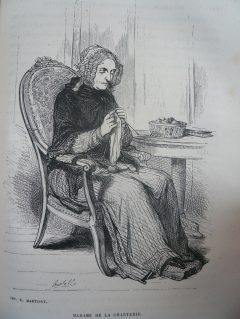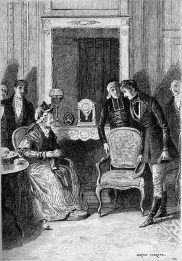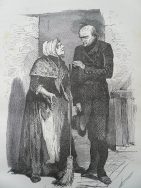
The Seamy Side of History
THE HUMAN COMEDY – Honoré de Balzac Twelfth volume of works of Honoré de Balzac edited by widow André Houssiaux, publisher, Hebert and Co, successors, 7 rue Perronet – Paris (1877) Scenes from Parisian life

Madame de la Chanterie
THE OTHER SIDE OF CONTEMPORARY HISTORY
In this tome, the historian places the last of the Scènes de la vie parisienne, L’Envers de l’histoire contemporaine and the first of the Scènes de la vie politique.
Analysis of the work L’Envers de l’histoire contemporaine was published in 1848. It is the final volume in the Scenes de la vie parisienne series of La Comédie humaine. L’Envers de l’histoire contemporaine is a misleading title. We believe that the novelist is going to reveal secrets, that it’s about what Stendhal called “the underside of the cards”. This is a mistake. This title, awarded late in 1846, had a completely different meaning. In Scènes de la vie parisienne, Balzac had just demonstrated the brutality and cynicism of his era. He wanted to correct this pessimistic impression that his work could give by showing that this selfish, ferocious society also had another side, an unknown “reverse”, like a coin, a side of selflessness, generosity and faith: what you don’t see, what you don’t know about your time, a correction that is true of all times. Balzac had been thinking about this for a long time. Back in 1833, Le Médecin de campagne, describing the philanthropic mission undertaken by Dr. Benassis in a deprived Alpine canton, established an initial contrast that was confirmed six years later, in 1839, the village priest, both of whom were taken in by the Scenes from country life. Around 1835, a handwritten study of a few pages, entitled Les Précepteurs en Dieu, already seems to herald a project similar to that of The other side of contemporary history. It has to be said that Balzac’s moral intention was accompanied by an intention that was not entirely disinterested. At the time he published Le Médecin de campagne, Balzac had had the satisfaction of being included by the Academicians on the list of writers likely to win the Prix Montyon, which, however, was not awarded to him. Since then, the Montyon prize has been a recurring preoccupation for Balzac. In Balzac’s dreams, it even had an importance disproportionate to its value. Balzac imagined that the Montyon prize offered twenty thousand francs, a considerable sum in those days, to a writer of a highly moral work. In reality, the Montyon prize was nine thousand francs, which the Académie shared between several kind souls. Balzac began by attributing it to a single beneficiary, and assumed that in consideration of his candidacy, the Académie would not fail to accumulate several years’ arrears. The Montyon prize was expressly mentioned by Balzac in 1842, in the letter he wrote to Madame Hanska announcing his plan to write The Brothers of Consolation under which he then designated The other side of contemporary history. In truth, Balzac’s project fully deserved the vote of the Academicians. Balzac’s intention was to describe the life of a small secret society of Christians who applied the prescriptions of the Gospel to the letter, devoting all their personal resources to helping those in obvious or hidden need. It was exactly the other side of the story of the thirteen. These conspirators of Christian charity are four in number, live in the deepest seclusion, know each other only by their first names, and are placed under the direction of a lady in her sixties called Mme de La Chanterie.

Madame de la Chanterie
The novel is the gradual discovery of this small group by a neophyte brought among them by chance. The motives that had determined the adhesion of each of the participants provided a simple thread to which all sorts of derivations could be connected. The various phases of the novel’s writing, from 1842 to 1848, show this quite clearly. A first fragment appeared in the Musée des familles in September 1842 under the title Les Méchancetés d’un saint . It’s the story of the man known in the group as M. Alain. He had lent his savings during the Directoire period to a friend of his, who for many years had no news of him, whom he cursed for leading a life of deprivation and almost misery, who believed himself betrayed and who twenty years later, after the end of the continental blockade, saw this friend who had remained faithful to him return, scrupulously handing over a fortune amassed in his name. A second fragment appeared in the Musée des familles in September 1843 under the title La Maladie du siècle. It was the story of the narrator himself, explaining why he had come to this silent thebaid on rue Chanoinesse after a failed life of squandering and selfishness.

Godefroy
A third fragment appeared, again in Family Museum in October and November 1843, under the title Madame de La Chanterie. It was the dramatic story of the founder of the little group who had thrown herself into this path of total Christian charity after a tragedy that belonged to the political history of Napoleon’s reign 1.er. These three short stories seemed unrelated. Their dimensions were fixed by an agreement between Balzac and Le Musée des familles. The magazine strictly limited the length of stories for its subscribers to 3,000 lines. This calibration had the effect of imposing on Balzac a process of gradual discovery of the mysteries of Les Frères de la Consolation. The three stories were first brought together in 1846 in Volume XII of La Comédie humaine under the title The other side of contemporary history. At the time, they were classified as Scenes from political life. This was the first episode of the L’Envers de l’histoire contemporaine, subtitled Madame de La Chanterie. The second episode, subtitled The Initiate, was written by Balzac in Wierzchownia, Ukraine, at the home of Madame Hanska, with whom Balzac had been staying since September 13, 1847, and from where he returned to Paris on February 15, 1848. This fragment, much longer than the previous ones, contains the story of the narrator’s first mission. It’s an even stranger adventure than the first two.  The narrator, known as Godefroid, is asked to investigate a bourgeois family living modestly in a suburb, in order to care for a patient who is never seen. Godefroid gradually discovers that the head of the family, an old man, and his grandson, a teenager, are living in complete squalor, while at the same time they are secretly staging a comedy of luxury and social status in a sanctuary off-limits to all eyes: there, a sick woman they are trying to save must believe that nothing has changed from the opulence she once knew. Godefroid is overwhelmed by the incredible challenge the old man and his grandson have been taking on for several years. Eventually, he learns that only one doctor can cure the strange patient hidden away in this retreat, a famous Polish-Jewish practitioner who demands exorbitant fees. He convinces his associates to make this expenditure. The patient is saved. But a series of circumstances force the old man to reveal his true name. We learn that he was the imperial prosecutor who ruthlessly prosecuted Mme de La Chanterie and her daughter before the Orne tribunal d’exception, resulting in the daughter’s death sentence, which was carried out, and a twenty-year prison sentence, part of which Mme de La Chanterie had to serve. The old man, understanding the evil he has done, goes to beg forgiveness, asking for it with “heart-rending” cries, in the name of Jesus who died on the cross”. At this moment, Balzac writes, Mme de La Chanterie appears like a specter at the door of her room, fainting: “By Louis XVI and Marie-Antoinette,” she says, “whom I see on their scaffold, by Madame Elisabeth, by my daughter, by yours, by Jesus, I forgive you.” Hearing this last word, the former prosecutor looks up and says: “Angels take their revenge like this…” Balzac returned to Paris on February 15, 1848, on the eve of the revolutionary days that were to put an end to the reign of Louis-Philippe. L’Initié, the second part of the novel, appeared in one of the new newspapers, Le Spectateur républicain, from August1, 1848. It was not published in volume until after Balzac’s death, in 1854, in Volume II of the supplementary volumes of La Comédie humaine, by a new publisher, Mme Houssiaux. What are we to make of this novel that so fearlessly turns sublime? It’s impossible not to notice the difference in firmness and authority between the portraits of these holy people and those of characters who live amidst the passions and calculations of the century. We don’t see any of the staged characters, not the gentle, inoffensive M. Alain who is the best characterized, not the narrator, not the other members of the society, not even Mme de La Chanterie, confused, painful, tense, but immobile like an idol. Events are no better. They’re all implausible, pushed to the sublime, but impossible – or disfigured. None of the touching stories we are told can be accepted by a reader with a modicum of critical thinking. No one can believe in this room full of wonders in which the unfortunate Wanda barks, in these sumptuous flowers renewed every day, in this musical and luxurious oasis hidden in an ignoble hovel, an illusion maintained against the whole world by an old man and a child. As for the story of Mme Aquet de Férolles, the dramatic, authentic story on which the tragic end of Mme de La Chanterie’s daughter and her own destiny are copied, Balzac gets rid of it by reproducing the indictment from the Mortagne chauffeurs’ affair that the Caen court clerk had sent him. But just read Gustave Lenôtre’s reconstruction of the events in Tournebut to see that Balzac has “evacuated” in favor of his saint, all the pathos of a dreadful police machination: and also the heroism, the terrible beauty of this episode of resistance, Mme de La Chanterie fanatical and secretive, and, before her, exposed in the pillory, the whole Rouen bourgeoisie parading respectfully, hat in hand. The cause of this falsification is easy to understand. There was, and could be, no connection between the admirable fanatic of reality and the saint Balzac wanted to portray. This mixture of affabulation and sweetening leaves a strange impression of unreality. Balzac creates the sublime, and sometimes we’re touched. But it does so at the expense of reality. At the time of Histoire des treize, he was inventing a melodrama of power. L’Envers de l’histoire contemporaine is a melodrama of charity. Does the sublime only exist at this price?
The narrator, known as Godefroid, is asked to investigate a bourgeois family living modestly in a suburb, in order to care for a patient who is never seen. Godefroid gradually discovers that the head of the family, an old man, and his grandson, a teenager, are living in complete squalor, while at the same time they are secretly staging a comedy of luxury and social status in a sanctuary off-limits to all eyes: there, a sick woman they are trying to save must believe that nothing has changed from the opulence she once knew. Godefroid is overwhelmed by the incredible challenge the old man and his grandson have been taking on for several years. Eventually, he learns that only one doctor can cure the strange patient hidden away in this retreat, a famous Polish-Jewish practitioner who demands exorbitant fees. He convinces his associates to make this expenditure. The patient is saved. But a series of circumstances force the old man to reveal his true name. We learn that he was the imperial prosecutor who ruthlessly prosecuted Mme de La Chanterie and her daughter before the Orne tribunal d’exception, resulting in the daughter’s death sentence, which was carried out, and a twenty-year prison sentence, part of which Mme de La Chanterie had to serve. The old man, understanding the evil he has done, goes to beg forgiveness, asking for it with “heart-rending” cries, in the name of Jesus who died on the cross”. At this moment, Balzac writes, Mme de La Chanterie appears like a specter at the door of her room, fainting: “By Louis XVI and Marie-Antoinette,” she says, “whom I see on their scaffold, by Madame Elisabeth, by my daughter, by yours, by Jesus, I forgive you.” Hearing this last word, the former prosecutor looks up and says: “Angels take their revenge like this…” Balzac returned to Paris on February 15, 1848, on the eve of the revolutionary days that were to put an end to the reign of Louis-Philippe. L’Initié, the second part of the novel, appeared in one of the new newspapers, Le Spectateur républicain, from August1, 1848. It was not published in volume until after Balzac’s death, in 1854, in Volume II of the supplementary volumes of La Comédie humaine, by a new publisher, Mme Houssiaux. What are we to make of this novel that so fearlessly turns sublime? It’s impossible not to notice the difference in firmness and authority between the portraits of these holy people and those of characters who live amidst the passions and calculations of the century. We don’t see any of the staged characters, not the gentle, inoffensive M. Alain who is the best characterized, not the narrator, not the other members of the society, not even Mme de La Chanterie, confused, painful, tense, but immobile like an idol. Events are no better. They’re all implausible, pushed to the sublime, but impossible – or disfigured. None of the touching stories we are told can be accepted by a reader with a modicum of critical thinking. No one can believe in this room full of wonders in which the unfortunate Wanda barks, in these sumptuous flowers renewed every day, in this musical and luxurious oasis hidden in an ignoble hovel, an illusion maintained against the whole world by an old man and a child. As for the story of Mme Aquet de Férolles, the dramatic, authentic story on which the tragic end of Mme de La Chanterie’s daughter and her own destiny are copied, Balzac gets rid of it by reproducing the indictment from the Mortagne chauffeurs’ affair that the Caen court clerk had sent him. But just read Gustave Lenôtre’s reconstruction of the events in Tournebut to see that Balzac has “evacuated” in favor of his saint, all the pathos of a dreadful police machination: and also the heroism, the terrible beauty of this episode of resistance, Mme de La Chanterie fanatical and secretive, and, before her, exposed in the pillory, the whole Rouen bourgeoisie parading respectfully, hat in hand. The cause of this falsification is easy to understand. There was, and could be, no connection between the admirable fanatic of reality and the saint Balzac wanted to portray. This mixture of affabulation and sweetening leaves a strange impression of unreality. Balzac creates the sublime, and sometimes we’re touched. But it does so at the expense of reality. At the time of Histoire des treize, he was inventing a melodrama of power. L’Envers de l’histoire contemporaine is a melodrama of charity. Does the sublime only exist at this price?
The Story The date given by Balzac at the end of the story is: August 1848. Here we’re talking about a charitable society: Les Frères de la Consolation, who live piously and secretly in a retreat run by their founder, Madame de La Chanterie. These characters live very modest lives, like their brothers in the monasteries. Compared to the evil-based organization of the History of the Thirteen, this is the association of good. The story begins with young Godefroid’s resolution to end his life of idleness and debauchery, which has ruined him. To this end, he is lured by a classified ad promising board and lodging for a very respectable price. On his way to the address indicated, he witnessed a moving scene. Indeed, he sees a man who comes to the aid of his fellow man, bringing comfort and consolation. In the building where he was staying, he met and recognized the person who had rescued the man in distress. As the days go by, he gets to know, appreciate and fall in love with the other tenants, as well as his landlady and landlady, Madame de La Chanterie. He was gradually introduced to their charitable activities, and trained to accept his first mission. This consists of investigating the life of a family who, on the surface, appear to be quite well off, but who in fact live in the most singular poverty. This family is hiding a horrible secret, both for themselves and for Madame de La Chanterie.
The characters Godefroy: Young man eager to get out of adolescence, learn a trade and make something of his life. His surname is unknown to us, and H. de Balzac says nothing about his family. Philiberte de Champignelles: Born in 1772 to a noble Norman family, Barbe-Philiberte de Champignelles, wife of Henri de la Chanterie born in 1763, maître des requêtes then president of the Revolutionary Court, then bigamist, died in 1802. Jean-Jules Popinot: Judge and co-founder of the company with Madame de la Chanterie and the vicar of Notre-Dame.
1) Source analysis: Preface compiled from the complete works of the Comédie Humaine (tome XVIII) published by France Loisirs 1985 under the auspices of the Société des Amis d’Honoré de Balzac.
2) Source for the story: Wikipedia. 3) Source: Félicien Marceau, “Balzac et son monde”, Gallimard.
No Comments